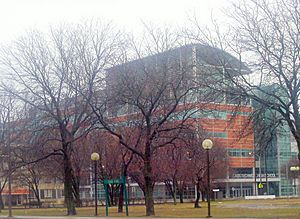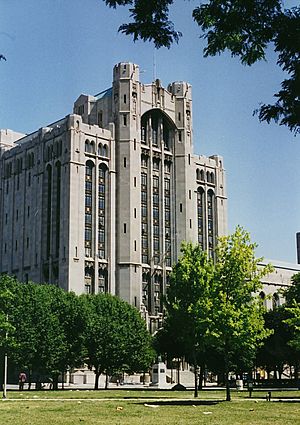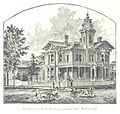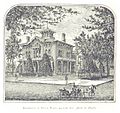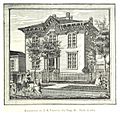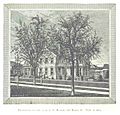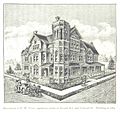Cass Park Historic District facts for kids
Quick facts for kids |
|
|
Cass Park Historic District
|
|
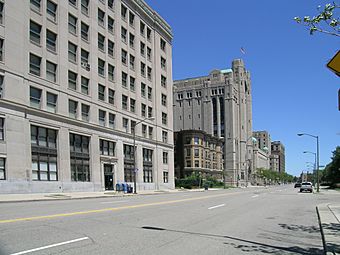
Temple Street north of Cass Park. The Detroit Masonic Temple is in the midground
|
|
| Location | Temple, Ledyard, and 2nd Sts, Detroit, Michigan, U.S. |
|---|---|
| Architect | Ellington & Weston; et al. |
| Architectural style | Classical Revival, Art Deco |
| NRHP reference No. | 04001580 |
| Added to NRHP | February 2, 2005 |
The Cass Park Historic District is a special area in Midtown Detroit, Michigan. It has 25 important buildings around a park called Cass Park. This district was added to the National Register of Historic Places in 2005. This means it is recognized as a place with important history. The city of Detroit also named it a historic district in 2016.
Contents
Exploring the History of Cass Park
How Cass Park Began
The land around Cass Park was once part of a long, narrow farm. These farms were called "ribbon farms" and stretched from the Detroit River. Lewis Cass, who the park is named after, bought this farm in 1816. He later built a large house nearby. Starting in 1836, Cass began dividing his land into smaller pieces. These pieces were sold to people who wanted to build homes. In 1860, Lewis Cass gave a piece of land to the city of Detroit. This land was meant to be a public park for everyone to enjoy.
Growth Around the Park
In 1863, streetcar service started nearby on Woodward Avenue. This made the Cass Park area a popular place to live. It quickly became a fashionable suburb of Detroit. In 1875, the city made Cass Park even nicer by planting many new trees. By the 1880s, some of Detroit's most important people lived near the park. One of these homes, the John H. Avery house, is still standing today.
From Homes to Apartments and Businesses
The Cass Park area stayed a popular place into the 1900s. Around the 1890s, larger apartment buildings started to appear. These buildings offered more homes for the city's growing population. By 1925, many new apartment buildings had been built.
Around the 1920s, businesses also started building their main offices near the park. The Standard Accident Insurance Company built its headquarters here in 1921. The Freemasons also bought land to build their new, much larger Detroit Masonic Temple. This huge building was finished in 1926. The Knights of Pythias built their headquarters next door in the same year. In 1927, the S. S. Kresge Corporation built its World Headquarters near the park.
Smaller businesses also opened along Cass Avenue. These included a commercial building for the Lasky Corporation and a garage. During World War II, many people moved to Detroit for work. Apartment owners divided their units into smaller spaces to house everyone.
Changes After the War
After World War II, the Cass Park area faced tough times. Many buildings became run down or were left empty. From the 1950s to the 1970s, the neighborhood struggled. Some helpful organizations moved in to assist people. For example, the Mariners Inn was built in 1955 as a shelter. The building of Interstate 75 also cut off the park from downtown. This made the area decline even more. Businesses moved away, and many buildings were either used by non-profits, abandoned, or torn down.
What You'll See in Cass Park Today
The Cass Park Historic District includes Cass Park itself. This park has paths, trees, and playground equipment. A statue of the famous poet Robert Burns stands on the north side of the park. The new Cass Technical High School is just south of the park. Many other important buildings surround the park.
The district has 25 buildings. Some of these buildings are no longer standing or do not add to the historic value. Two buildings, the S.S. Kresge Company Headquarters and the Detroit Masonic Temple, are so important they are listed on the National Register of Historic Places on their own.
Let's look at some of the buildings in the district:
Buildings South of Cass Park
- Mariners Inn, 445 Ledyard: This two-story brick office building was built in 1955. It was designed by Charles Vogel for the Episcopal Church. It is still used today as a shelter and treatment center.
- John H. Avery House, 457 Ledyard: This red-brick house was built in 1878. It is one of the few original single-family homes left in the area. It has fancy carved stone details around the windows.
- Michigan Chronicle, 479 Ledyard: This two-story brick office building was built in 1936. It was first used for film exchange. In the 1960s, it became home to the Michigan Chronicle. This was the first newspaper in Detroit owned by African-Americans. The building has a modern limestone front.
Buildings West of Cass Park
- S.S. Kresge Company / Metropolitan Center for High Technology, 2727 Second: This large brick and limestone office building was designed by Albert Kahn. It was built between 1928 and 1930. The Kresge company used these offices until 1972. It is a great example of Art Deco style.
Buildings North of Cass Park
- Fort Wayne Hotel / American Hotel, 400–426 Temple : This 11-story building was built in 1926. It was designed by Ellington and Weston. It was originally a lodge headquarters and hotel for the Knights of Pythias. It has decorative stone and tile details.
- Detroit Masonic Temple, 500 Temple: This amazing English Gothic building was designed by George D. Mason. Construction started in 1922. It is the largest Masonic Temple in the world. It has three connected buildings and is covered in Indiana limestone.
- Standard Accident Insurance Building / Wayne County Department of Social Services, 640 Temple: This eight-story brick and stone office building was designed by Albert Kahn. It was built in 1920 in a Classical Revival style.
- Ansonia Flats / Ansonia Apartments, 2901–23 Second: This yellow brick apartment building was built in 1908. It had 20 luxury apartments. It has a unique wavy shape with many windows.
- Boulevard Hotel, 2931–33 Second: This brown brick apartment building was built in 1924. It has a Craftsman-style design with a central entrance.
- Cromwell Flats / Cromwell Apartments, 2942 Second: This brown brick apartment building was designed by Almon C. Varney and built in 1904. It has alternating bands of brick and stone.
- Altadena Apartments, 2952–58 Second: This brown brick apartment building was built in 1911. It has two entrances and special window bays on each end.
- Manhattan Apartments, 2966–72 Second: This brown brick apartment building was built in 1905. It has a central entrance and unique metal details.
- Wilburne Apartments, 487 Charlotte: This yellow brick apartment building was built in 1916. It has a wide roof supported by brackets. It is now called the Vernon Murphy Apartments.
Buildings On or East of Cass Avenue
- Temple Bar, 2906–14 Cass Avenue: This single-story brick commercial building was built in 1925. Its front was updated in 1941 with a sleek, modern look.
- 2930 Cass Avenue: This three-story brown brick commercial building was built in 1915. It originally housed a drug store with apartments upstairs.
- 2949 Cass Avenue: This two-story commercial building was designed by Albert Kahn and built in 1922. It was used as a film exchange building.
- Alhambra Flats / The Embassy, 100–112 Temple: This six-story brick and stone apartment building was built in 1895. It has a Romanesque Revival style with heavy rounded arches.
- The Alden, 145 Temple: This brick apartment building was built in 1922. It has a Renaissance Revival style with a classic door design.
- 146–166 Temple: This three-story commercial building was built in 1923. It has storefronts on the first floor and tall windows above.
Images for kids
See also
 In Spanish: Distrito Histórico de Cass Park para niños
In Spanish: Distrito Histórico de Cass Park para niños
- Cass Corridor
- Cass-Davenport Historic District


